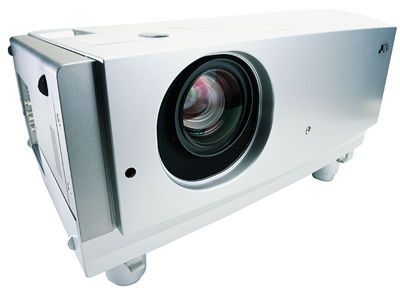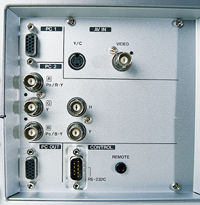The review suggests that while the D-ILA technology has impressive resolution, it requires careful calibration for optimal performance, as internal adjustments significantly impact picture quality. A must-read for those considering this projector or interested in the intricacies of D-ILA tech.
geometry dash
JVC DLA-G150CL D-ILA front projector

The DLA-G150CL is the latest iteration of JVC's combination of D-ILA and xenon arc lamp. It's not lightweight; at 32 pounds, it's more of a CRT-on-a-diet design. You can use the DLA-G150CL on a desktop, but it's probably best mounted in a permanent installation. Several optional lenses will make the job easier, including some long zoom lenses, and even one lens with mechanical offset.
When tuned up properly, D-ILA is a formidable competitor to Texas Instruments' DLP. The three D-ILA devices used in this projector measure 0.9 inch diagonally, and each has a native pixel resolution of 1365x1024 (considered to be SXGA), which corresponds to a native 4:3 aspect ratio. The liquid crystals use a vertical alignment pattern to shutter light, and the spacing between pixels is extremely small. The result is a 93% aperture ratio for each pixel, meaning 93% of the imaging surface is available to shutter light.
Because of the DLA-G150CL's SXGA native resolution, it qualifies as an HDTV display and can show all the detail in a 1280x720 signal with no pixel decimation (downscaling). Sources at 1920x1080i are compressed in a linear fashion by 29% to fit the width of the screen, resulting in an effective resolution of 1365x727 pixels. All other inputs can be enlarged to fill the screen or mapped 1:1, as desired.
The xenon arc lamp presents a quandary. On one hand, its white point is much closer to D6500, and the lamp exhibits more even spectral output than the UHP, UHM, or other short-arc lamps used in most LCD and DLP home theater projectors. On the other hand, the lamp costs about $900 to replace and lasts about 1000 hours. That's 2.5 times the cost of those competing short-arc lamps, which are claimed to run for 3000 hours or more. Cost vs. quality . . . hmmm, where have we heard that one before?
What's in the Box
The DLA-G150CL isn't the sleekest- or sexiest-looking projector out there. Rather, it's a workmanlike design in which function comes first. Think of a large shoebox with leveling legs and self-contained lens and you'll get the idea. But since you'll probably install the projector out of the way, looks aren't all that important.
 The DLA-G150CL ships with one of four optional lenses. The GL-M2910G is a 1:1, on-axis lens for extremely short throws; you can fill an 80-inch-wide screen from a distance of 6.5 feet. The GL-M2915SG is another fixed lens with a more traditional 1.5:1 ratio, just like a good ol' CRT projector; you can shift it 30–55% vertically off-axis using the manual lens-shift feature. For longer throws, the GL-M2920ZG is a 2–3:1 ratio zoom with a fixed +50% vertical image shift. The GL-M2930SZG goes longer still, with a 2.9–5.5:1 zoom ratio and 30–55% vertical lens shift. The review unit was shipped with the GL-M2920ZG zoom lens, which filled an 80-inch-wide screen at distances from 12' 10" to 19' 3".
The DLA-G150CL ships with one of four optional lenses. The GL-M2910G is a 1:1, on-axis lens for extremely short throws; you can fill an 80-inch-wide screen from a distance of 6.5 feet. The GL-M2915SG is another fixed lens with a more traditional 1.5:1 ratio, just like a good ol' CRT projector; you can shift it 30–55% vertically off-axis using the manual lens-shift feature. For longer throws, the GL-M2920ZG is a 2–3:1 ratio zoom with a fixed +50% vertical image shift. The GL-M2930SZG goes longer still, with a 2.9–5.5:1 zoom ratio and 30–55% vertical lens shift. The review unit was shipped with the GL-M2920ZG zoom lens, which filled an 80-inch-wide screen at distances from 12' 10" to 19' 3".
As a true professional projector, the DLA-G150CL has every popular video-input connector, independently accessible from the spacious remote control. There's a single BNC jack for composite video, a DIN jack for S-video, and three more BNCs for Y-Pb-Pr component connections from DVD players or DTV set-top receivers.
Need more jacks? How about five more BNC connectors, which can do double duty as RGBHV or Y-Pb-Pr inputs? There's also a 15-pin D-sub jack for connection to a PC (this input has a monitor-output loop connector), and a DVI-D input for pure digital signals. Two 9-pin RS-232C jacks round out the picture for remote-control systems.
The DLA-G150CL has no onboard audio of any kind—JVC assumes that you'll have a good audio system to go with it. Nor is there any provision for routing audio through the projector to compensate for time delays induced by progressive-scan conversions, which aren't really that much of a problem to begin with.
The internal fan was so quiet that I could sit within a few feet of the projector and not notice it. The fan was a lot quieter than the blower on my older Sony VPH-D50HTU projector, and it put more than a few microportable LCD and DLP projectors to shame. The power zoom and focus were also quiet, maybe even too quiet—other than watching images go slowly in and out of focus, it was hard to tell when I'd engaged it.
- Log in or register to post comments


A home theater projector that is SXGA+ is the JVC DLA-G150CL. At its brightest setting, this lamp-based projector can display scratch games 1,000 lumens with a native resolution of 1365x1024. First made available for purchase in January 2002, this projector has now been discontinued by JVC.

I first heard about aviator ghana from a friend who plays regularly. He told me it’s all about knowing when to cash out before the plane crashes. I didn’t believe him at first, but after playing a few rounds, I realized how much strategy is involved. The game is super popular here in Ghana, and I can see why. The thrill of making that perfect call, cashing out at the right time, and seeing your balance grow is unbeatable. Definitely my new favorite way to pass time!






























































